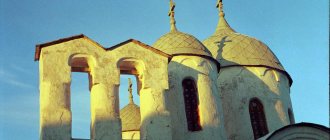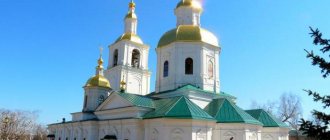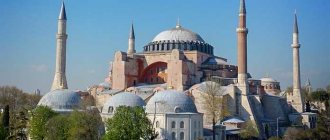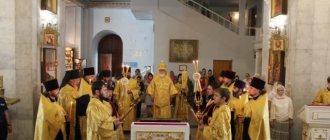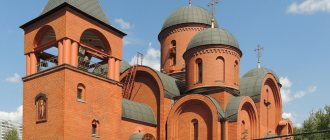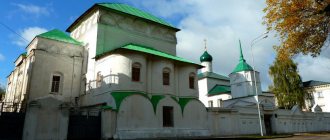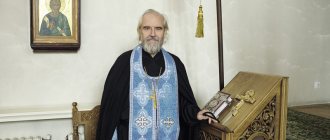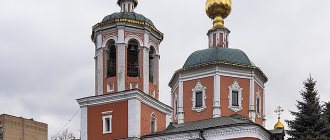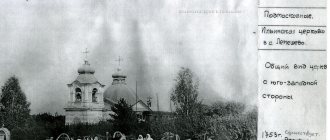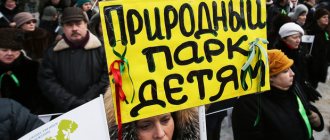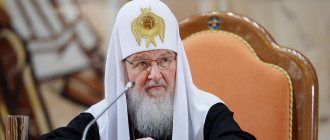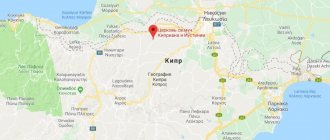Mir
Russia Moscow Region Sergiev Posad Pyatnitskoe Metochion of the Trinity-Sergius Lavra Map loading in progress...
{"format":"leaflet","minzoom":false,"maxzoom":false,"limit":50,"offset":0,"link":"all","sort":[""], "order":[],"headers":"show","mainlabel":"","intro":"","outro":"","searchlabel":"\u2026 \u0441\u043b\u0435\ u0434\u0443\u044e\u0449\u0438\u0435 \u0440\u0435\u0437\u0443\u043b\u044c\u0442\u0430\u0442\u044b","default":"","import-annotation":false,"width ":"auto","height":"350px","centre":{"text":"","title":"""link":"""lat":56.30854099999999817782736499793827533721923828125,"lon": 38.132778000000001838998286984860897064208984375,"icon":""},"title":"","label":"","icon":"","lines":[],"polygons":[],"circles":[ ],"rectangles":[],"copycoords":false,"static":false,"zoom":8,"defzoom":14,"layers":["OpenStreetMap"],"image layers":[] ,"overlays":[],"resizable":false,"fullscreen":true,"scrollwheelzoom":true,"cluster":false,"clustermaxzoom":9,"clusterzoomonclick":true,"clustermaxradius":80, "clusterspiderfy":true,"geojson":"","clicktarget":"","showtitle":true,"hidenamespace":false,"template":"","userparam":"","activeicon": "","pagelabel":false,"ajaxcoordproperty":"","ajaxquery":"","locations":[{"text":"\u003Cb\u003E\u003Ca href=\"/palomnik/%D0% 9F%D1%8F%D1%82%D0%BD%D0%B8%D1%86%D0%BA%D0%BE%D0%B5_%D0%BF%D0%BE%D0%B4%D0%B2% D0%BE%D1%80%D1%8C%D0%B5_%D0%A2%D1%80%D0%BE%D0%B8%D1%86%D0%B5-%D0%A1%D0%B5%D1 %80%D0%B3%D0%B8%D0%B5%D0%B2%D0%BE%D0%B9_%D0%BB%D0%B0%D0%B2%D1%80%D1%8B\" title= \u041f\u044f\u0442\u043d\u0438\u0446\u043a\u043e\u0435 \u043f\u043e\u0434\u0432\u043e\u0440\u044c\u0435 \u0422\u0440\u043 e\u0438\u0446\u0435-\ u0421\u0435\u0440\u0433\u0438\u0435\u0432\u043e\u0439 \u043b\u0430\u0432\u0440\u044b\u003E\u041f\u044f\u0442\u043d\u0438\u 0446\u043a\u043e\u0435\ u043f\u043e\u0434\u0432\u043e\u0440\u044c\u0435 \u0422\u0440\u043e\u0438\u0446\u0435-\u0421\u0435\u0440\u0433\u0438\u0435\u0 432\u043e\u0439\u043b\u0430 \u0432\u0440\u044b\u003C/a\u003E\u003C/b\u003E\u003Chr /\u003E\u003Ca href=\»/palomnik/%D0%A1%D0%B2%D0%BE%D0%B9%D1 %81%D1%82%D0%B2%D0%BE:%D0%90%D0%BD%D0%BD%D0%BE%D1%82%D0%B0%D1%86%D0%B8%D1% 8F\" title=\"\u0421\u0432\u043e\u0439\u0441\u0442\u0432\u043e:\u0410\u043d\u043d\u043e\u0442\u0430\u0446\u0438\u044f\"\u003E\u04 10\u043d \u043d\u043e\u0442\u0430\u0446\u0438\u044f\u003C/a\u003E: \u0441\u043e\u0441\u0442\u043e\u0438\u0442 \u0438\u0437 \u0445\u0 440\u0430\u043c\u0430\ u0441\u0432\u044f\u0442\u043e\u0439 \u0432\u0435\u043b\u0438\u043a\u043e\u043c\u0443\u0447\u0435\u043d\u0438\u0446\u044b \u0 41f\u0430\u0440\u0430\u0441\ u043a\u0435\u0432\u044b \u041f\u044f\u0442\u043d\u0438\u0446\u044b \u0438 \u0412\u0432\u0435\u0434\u0435\u043d\u0441\u043a\u 043e\u0439\u0446\u0435\u0440\ u043a\u0432\u0438, \u043a\u043e\u0442\u043e\u0440\u044b\u0435 \u0440\u0430\u0441\u043f\u043e\u043b\u043e\u0436\u0435\u043d\u 044b\u0441\u044e\u0433\u043e -\u0432\u043e\u0441\u0442\u043e\u0447\u043d\u043e\u0439 \u0441\u0442\u043e\u0440\u043e\u043d\u044b \u041b\u0430\u0432\u0440\ u044b.","title": "" \u0438\u0446\u0435-\u0421 "link":""lat":56.308540999999998177827364997938 27533721923828125,"lon":38.132778000000001838998286984860897064208984375,"icon" :""}],"imageLayers":[]}
56.30862; 38.132819
Russia, Moscow region, Sergiev Posad, Red Army Avenue, 127
Sergiev Posad, Moscow region 141309
Russia
Pyatnitskoye Compound
The Trinity-Sergius Lavra consists of the Church of the Holy Great Martyr Paraskeva Pyatnitsa and the Church of the Presentation, which are located on the south-eastern side of the Lavra. Divine services are held daily in the courtyard.
History[edit]
Pyatnitskaya and Vvedenskaya churches are the oldest churches in Sergiev Posad outside the walls of the Holy Trinity Sergius Lavra. They are located in close proximity to the Lavra, on a place that in the old days was called “Podol”, a crowded and busy place, since the trade route from Moscow to Alexandrova Sloboda passed here, and there was a trading area.
Back in the time of St. Nikon, student of St. Sergius of Radonezh, a wooden church was built in honor of the Entry into the Temple of the Blessed Virgin Mary with a chapel in the name of St. Vmch. Paraskeva Fridays. In 1547, boyar Ivan Khabarov (in the monkhood Joasaph) erected two stone churches on the site of the old building: the Entry into the Temple of the Blessed Virgin Mary and St. VMC. Paraskeva Fridays.
In the middle of the 18th century. Podolny churches left the jurisdiction of the Lavra and became parish churches. The new Vvedensky parish of the Klementyevsky deanery existed until March 1896, after which both churches were returned to the Lavra.
On October 21, 1919, the closure of the Holy Trinity Sergius Lavra occurred - the brethren of the monastery were expelled from the monastery. Some of the monks moved to the Gethsemane monastery, where a workers’ and labor artel was created, while others remained at the Pyatnitsky metochion, which received the name “Small Lavra”. And even earlier, in the early spring of 1919, a decree was issued on the closure of the Moscow Theological Academy, the premises of which were occupied by Electrical Engineering Courses. The academic professors and students left without a church were received at the Pyatnitsky courtyard of the Lavra. There, lectures continued, and academic clergy took part in daily services. This is how “theorists” and “practitioners” united. Until 1928, statutory monastic services were held here. In 1928, the Vvedenskaya and Pyatnitskaya churches were closed. In 1931, a mill was organized in the Pyatnitsky church, and a grain warehouse was organized in Vvedensky.
Pyatnitsky Metochion of the Trinity-Sergius Lavra - attractions
Temple in the name of St. The Great Martyr Paraskeva Pyatnitsa and the Church of the Presentation are located on the south-eastern side of the Lavra. Divine services are held daily in the courtyard. There is also a Sunday school at the courtyard for children from 3 to 16 years old. For adults, weekly “Gospel meetings” are held on Wednesdays after the end of the evening service (18.30 – 20.00), which are conducted by teachers from the Department of Biblical Studies of the Moscow Theological Academy.
Pyatnitskaya and Vvedenskaya churches are the oldest churches in Sergiev Posad outside the walls of the Holy Trinity Sergius Lavra. They are located in close proximity to the Lavra, on a place that in the old days was called “Podol”, a crowded and busy place, since the trade route from Moscow to Alexandrova Sloboda passed here, and there was a trading area.
Back in the time of St. Nikon, student of St. Sergius of Radonezh, a wooden church was built in honor of the Entry into the Temple of the Blessed Virgin Mary with a chapel in the name of St. Vmch. Paraskeva Fridays. In 1547, boyar Ivan Khabarov (in the monkhood Joasaph) erected two stone churches on the site of the old building: the Entry into the Temple of the Blessed Virgin Mary and St. VMC. Paraskeva Fridays.
In the middle of the 18th century. Podolny churches left the jurisdiction of the Lavra and became parish churches. The new Vvedensky parish of the Klementyevsky deanery existed until March 1896, after which both churches were returned to the Lavra.
On October 21, 1919, the closure of the Holy Trinity Sergius Lavra occurred - the brethren of the monastery were expelled from the monastery. Some of the monks moved to the Gethsemane monastery, where a workers’ and labor artel was created, while others remained at the Pyatnitsky metochion, which received the name “Small Lavra”. And even earlier, in the early spring of 1919, a decree was issued on the closure of the Moscow Theological Academy, the premises of which were occupied by Electrical Engineering Courses. The academic professors and students left without a church were received at the Pyatnitsky courtyard of the Lavra. There, lectures continued, and academic clergy took part in daily services. This is how “theorists” and “practitioners” united. Until 1928, statutory monastic services were held here. In 1928, the Vvedenskaya and Pyatnitskaya churches were closed. In 1931, a mill was organized in the Pyatnitsky church, and a grain warehouse was organized in Vvedensky.
On August 8, 1991, the Vvedenskaya, Pyatnitskaya churches and the Pyatnitsky well were returned to the Holy Trinity Sergius Lavra in a dilapidated state, and for more than 20 years work has been carried out to restore the churches. In the Vvedensky Church, the iconostasis and the interior decoration of the temple have not yet been completed. Pyatnitskaya Chapel was restored in 1962 by architect V.I. Baldin. At the first stage, all three tiers of the roof were covered with a crenate aspen plowshare according to the ancient model. And on the second, newly made columns were installed on the walls below the octagon, framed by windows and a portal, and a lining was arranged with a figured fence (1976)
On the eve of the first patronal feast day, the first icon of the holy martyr arrived in the temple. Paraskeva Fridays. It was a color lithograph from an ancient icon, presumably from the 13th century. On it, the saint holds in her hand a scroll with the Creed in the form of a question mark. Her image turned out to be miraculous, which was witnessed by many people. In August 1996, church parishioner Galina Skeris ordered Irina Belyakova, an icon painter from Washington, to paint a copy of the icon of St. Vmch. Paraskeva Fridays. The sample was a photograph of a temple image. The icon was painted during the Dormition Fast and was completed on the Dormition. Then the icon made a long journey to Turkey and Greece, where it was consecrated on the holy relics of the great martyr. Paraskeva in Athens and arrived at the Pyatnitsky Church.
Currently, the Pyatnitskoye Metochion still unites the Lavra and academic clergy. On March 20, 2013, by decree of His Holiness Patriarch Kirill of Moscow and All Rus', Archpriest Pavel Velikanov, associate professor of the Moscow Theological Academy, was appointed rector of the Compound. One of the regular participants in divine services at the Compound is the Deputy Chairman of the Educational Committee of the Russian Orthodox Church on accreditation and licensing, IBC teacher Priest Mikhail Vakhrushev.
Since Holy Week 2013, daily services have been held in the churches of the metochion. The beginning of the evening service is 17.00, the Divine Liturgy is 8.00. On Sundays, the early Divine Liturgy, as a rule, is celebrated in the Vvedensky Church; start – 6.30. In the Pyatnitsky Church on Sundays at 9.00 a general or water-blessing prayer is held. The late Divine Liturgy begins at 9.30.
Current state[edit]
On August 8, 1991, the Vvedenskaya, Pyatnitskaya churches and the Pyatnitsky well were returned to the Holy Trinity Sergius Lavra in a dilapidated state, and for more than 20 years work has been carried out to restore the churches. In the Vvedensky Church, the iconostasis and the interior decoration of the temple have not yet been completed. Pyatnitskaya Chapel was restored in 1962 by architect V.I. Baldin. At the first stage, all three tiers of the roof were covered with a crenate aspen plowshare according to the ancient model. And on the second, newly made columns were installed on the walls below the octagon, framed by windows and a portal, and a lining was arranged with a figured fence (1976)
On the eve of the first patronal feast day, the first icon of the holy martyr arrived in the temple. Paraskeva Fridays. It was a color lithograph from an ancient icon, presumably from the 13th century. On it, the saint holds in her hand a scroll with the Creed in the form of a question mark. Her image turned out to be miraculous, which was witnessed by many people. In August 1996, church parishioner Galina Skeris ordered Irina Belyakova, an icon painter from Washington, to paint a copy of the icon of St. Vmch. Paraskeva Fridays. The sample was a photograph of a temple image. The icon was painted during the Dormition Fast and was completed on the Dormition. Then the icon made a long journey to Turkey and Greece, where it was consecrated on the holy relics of the great martyr. Paraskeva in Athens and arrived at the Pyatnitsky Church.
In November 2003, a blessing was received for the construction of the Church of the All-Merciful Savior in the village of Zvezdochka. According to the design, this temple is two-story; services are already held on the first floor, although construction work has not yet been completed.
Currently, the Pyatnitskoye Metochion still unites the Lavra and academic clergy.
Pyatnitsky well
In the Trinity-Sergius Lavra and its immediate surroundings there are three springs, the water of which has long been considered healing by believers. The Pyatnitsky well, according to one version, was created by Sergius of Radonezh himself, the Assumption Key is associated with a miracle that occurred during the renovation of the cathedral, and the third revered spring may have been dug by Saint Sava of Zvenigorod.
If you look closely, you can see an interesting icon above the entrance to the Nadkladeznaya Chapel of the Trinity-Sergius Lavra. It depicts two monks standing near a rock from which a stream of water flows. This plot is described in the life of St. Sergius of Radonezh, compiled by his disciple Epiphanius. From the very beginning, Sergius settled in a place where there was no suitable source of water nearby. When the hermit lived alone, he carried water for himself from somewhere far away. After many followers gathered around the saint, they, according to Epiphanius, began to accuse their teacher of having thoughtlessly built the monastery too far from the spring.
Upset by the reproaches, Sergius left the monastery, taking one of the monks with him, and “went into the depths of the forest near the monastery, where there was no running water, as the old people definitely said. I found some water left after the rain in one ditch, and, kneeling down, began to pray.” After Sergius’ prayer, a spring emerged from the ground, which, according to the author of the life, began not only to be used for the needs of the monks, but began to be revered in the area as a healing spring. This well was named after Sergius during the life of the saint, but he himself forbade calling it that and said: “So that I never hear that you call this source by my name. After all, it was not I who gave this water, but the Lord gave it to us, the unworthy.”
It is not known exactly where the source that appeared through Sergius’ prayer came from. Most often it is identified with the Pyatnitsky well, which is located outside the walls of the Lavra in a beautiful white chapel on the other side of the Red Army Avenue from the monastery. There, even today you can get holy water, which flows from taps inserted into a decorative cross. This source is called Pyatnitsky after the Church of St. Paraskeva, which is located on the other side of the road. Church historian E. Golubinsky believed that the true source of Sergius, described in the life, most likely closed and disappeared without a trace. The Pyatnitsky well, according to Golubinsky, was dug much later for the needs of the Pyatnitsky Church and the almshouse that existed in these places.
Despite the historian’s doubts, the rumor that the source at the Pyatnitsky Gate is the legendary key that appeared through the prayer of Sergius has existed for centuries. In the seventeenth century, the ancient life of Sergius was supplemented with a list of miracles of the Radonezh righteous man. Among them, the case of healing of governor Dmitry Kaisa, who suffered from a serious leg disease, is mentioned. “After the prayer service, Demetrius was taken to a source that had emerged through the prayers of the saint; he plunged both legs into the water up to the knee and, thus, through the prayers of the saint, he was healed, as if he had not suffered from anything.”
Temples
- Church of the Holy Great Martyr Paraskeva Pyatnitsa
- Vvedensky Temple
- Chapel "Pyatnitsky Well" ("Sergius Well")
- Church of the All-Merciful Savior in the village of Zvezdochka
History of changes in the Unified State Register of Legal Entities for 2003–2018
2018
- 11.04.2018
- GRN
2187700304834 - SPVZ code
13801
- Code NO
7700
Department of the Federal Tax Service for Moscow
Submission of information on the issuance or replacement of identity documents of a citizen of the Russian Federation on the territory of the Russian Federation
2013
- 05.08.2013
- GRN
2135099000870 - SPVZ code
15101
- Code NO
7700
Department of the Federal Tax Service for Moscow
Making changes to information about a legal entity contained in the Unified State Register of Legal Entities due to errors made by the registration authority
- 27.06.2013
- GRN
2135099000804 - SPVZ code
12204
- Code NO
7700
Department of the Federal Tax Service for Moscow
Making changes to information about a legal entity contained in the Unified State Register of Legal Entities due to errors made by the applicant in a previously submitted application
Documentation:
- The decision on registration adopted by the Russian Ministry of Justice on June 13, 2013
- Рн0004 application for correction of errors, admitted in other registration documents but (clause 4.3)
- 19.06.2013
- GRN
2135099000793 - SPVZ code
12201
- Code NO
7700
Department of the Federal Tax Service for Moscow
Changing information about a legal entity contained in the Unified State Register of Legal Entities
Documentation:
- Рн0004 application for amendment of information not related to constituent documents
- The decision on registration adopted by the Russian Ministry of Justice on June 11, 2013
- Decree dated March 20, 2013
2012
- 13.12.2012
- GRN
2125099001388 - SPVZ code
13200
- Code NO
7700
Department of the Federal Tax Service for Moscow
Submission of information on registration of a legal entity with the tax authority
- 13.12.2012
- GRN
2125099001377 - SPVZ code
12101
- Code NO
7700
Department of the Federal Tax Service for Moscow
State registration of changes made to the constituent documents of a legal entity related to changes to information about a legal entity contained in the Unified State Register of Legal Entities, based on an application
Documentation:
- Рн0003 application for changes in information included in the accounting document
- Order dated November 26, 2012
- Charter of the legal entity dated October 31, 2012
- Extract from magazine No. 13 dated 04/12/2012
2010
- 19.03.2010
- GRN
2105000047898 - SPVZ code
13400
- Code NO
5000
Department of the Federal Tax Service for the Moscow Region
Submission of information on registration of a legal entity as an insurer in the executive body of the Social Insurance Fund of the Russian Federation
2006
- 20.06.2006
- GRN
2065000103320 - SPVZ code
13300
- Code NO
5000
Department of the Federal Tax Service for the Moscow Region
Submission of information on registration of a legal entity as an insurer in the territorial body of the Pension Fund of the Russian Federation
- 02.06.2006
- GRN
2065000080528 - SPVZ code
13300
- Code NO
5000
Department of the Federal Tax Service for the Moscow Region
Submission of information on registration of a legal entity as an insurer in the territorial body of the Pension Fund of the Russian Federation
2005
- 10.11.2005
- GRN
2055000051566 - SPVZ code
13200
- Code NO
5000
Department of the Federal Tax Service for the Moscow Region
Submission of information on registration of a legal entity with the tax authority
2003
- 13.03.2003
- GRN
1035000009440 - SPVZ code
11101
- Code NO
5000
Department of the Ministry of the Russian Federation for Taxes and Duties for the Moscow Region
Entering into the Unified State Register of Legal Entities information about a legal entity registered before July 1, 2002
